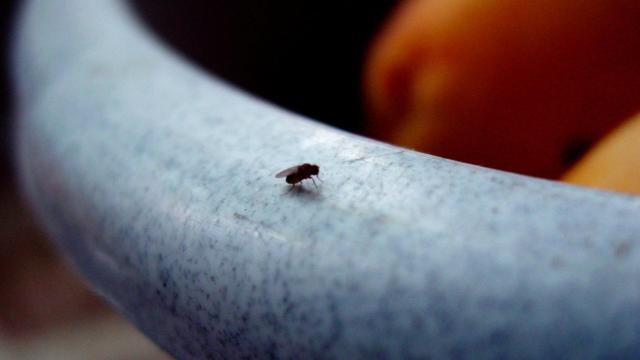“Guess,” says my boyfriend, as he now does every morning, before turning on the coffee kettle. “Fifteen,” I reply without looking up from my laptop. “You owe me ten bucks,” he beams. “Way over fifty.” He means fruit flies, of course.
Ever since the downstairs neighbour asked us to remove the bird feeder (it was attracting rats), guessing how many fruit flies we’ve trapped with our kitchen flypaper strip has become the primary source of excitement in our household. It’s not like insect gambling was our first choice. By July, when the flies first appeared, we’d already sated our appetite for experimental salads, overestimated our ability to invent backstories for Antiques Roadshow attendees, and consumed all the backgammon, gin, and heavy historical texts we could stomach.
The fruit fly flood began as a slow trickle. First there was one meandering around the cutting board, then three, then a full-on occupation inside the fridge. I suggested that we might have brought their eggs home with fruit from the grocery store. My boyfriend confidently overrode my theory with a totally unsubstantiated answer. “The drain,” he stated, as though the flies somehow followed the distant scent of a rotting peach a quarter of a mile north, slogging, Shawshank Redemption-style, through the sewer to the land of plenty in our third-floor apartment. This led to a days-long debate about how drainage works and a lot of seriously, how far do you think a fruit fly can smell?
Naturally, we had to murder them all. And so, out of necessity and a profound sense of boredom, I soon came to treasure an underappreciated technology: flypaper.
Compared to other hobbies, flypaper ownership is fairly easy to get into. Flypaper is almost invisible until you need it, but once you do, it seems to be everywhere, both cheap and plentiful. This is especially reassuring in a world where whispers of “supply chain shortages” haunt every shopper. It isn’t clear what the shelf life of this product is, but I like to imagine that it’s endless: that every corner store has been stocking dusty mountains of flypaper in the basement since the 1970s and that flypaper will outlast the human race. My four-pack of Pic Fly Ribbon was only $2. On a long enough timeline, the flies-per-cent value is potentially infinite.
Commercial flypaper is said to be more than a century old, invented in 1861 by a German baker who hung a sheet of molasses-coated wrapping paper in his window. In the years to come, arsenic was added, making it a convenient purchase for poisoners hoping to eliminate larger nuisances. Sensational flypaper murder trials and Holmesian inquiries followed. In 1889, the 26-year-old “fly-paper murderess” Florence Maybrick was found guilty of poisoning her older wealthy British husband with arsenic from a dozen sheets of flypaper, mixed in a meat extract and administered through his packed lunch. (Maybrick’s passionate testimony won the hearts of the public, some of whom formed the “International Maybrick Association,” and her death sentence was commuted.) In 1911, London insurance company superintendent Frederick Seddon poisoned his tenant, “spinster” Eliza Mary Barrow, and convinced her to appoint him the executor of her will on her deathbed. The cause of death was initially pronounced diarrhoea, but skillful investigators uncovered a link to flypaper with the arsenic found in Barrow’s exhumed body. Seddon was hanged. Evidently, drugstore flypaper contained some kind of poison until at least 1932, when a Chicago woman was convicted for flypaper-poisoning her nephew.
That’s probably more than you wanted to know about flypaper history, but isn’t it fascinating? For the record, the label on my own Pic flypaper states that it contains “NO POISONS” while also recommending it be kept out of the reach of children and domestic animals. (According to the admirably specific blog fliesonly dot com, flypaper strips contain a scent undetectable to humans but very attractive to flies.)
Once you have a roll of modern, poison-free flypaper, there are two ways to unfurl it. There’s the boyfriend way, where you ignore the instructions and yank the red loop straight down like a ripcord, resulting in a gnarly, charmless brown tube. Then there’s the correct way, where you delicately twist the cylinder like a champagne cork so that the flypaper (or “fly ribbon,” in industry parlance) unfurls into a flat, amber streamer of death, hanging like a diaphanous tongue over your cutting board of fresh snow peas.
In our home, we’ve constructed a fruit fly Pleasure Island around the streamer, placing it under a fluorescent light and over a glass of expired orange juice. (Fruit flies prefer fermentation.) A rounded glass is best, because, according to a University of Washington study, fruit flies seek globular objects, which is why they congregate around wine goblets. By morning, the paper is covered with flies, some still struggling to free their tiny legs and others half-melted, engulfed in glue.
These days, attention-hungry devices seem to crowd every surface, demanding our physical and mental space. Unlike them, flypaper asks for nothing. It is slim, cordless, silent, takes no time to set up, and runs in the background. This perfect tech gets the otherwise impossible task of fly extinction done in about 72 hours — almost entirely on its own. All of that, however, is just a prelude to the most joyous part of the entire experience: the moment when you admire the flypaper’s work, drop it in the trash, and move on to a better, less fly-filled life.
